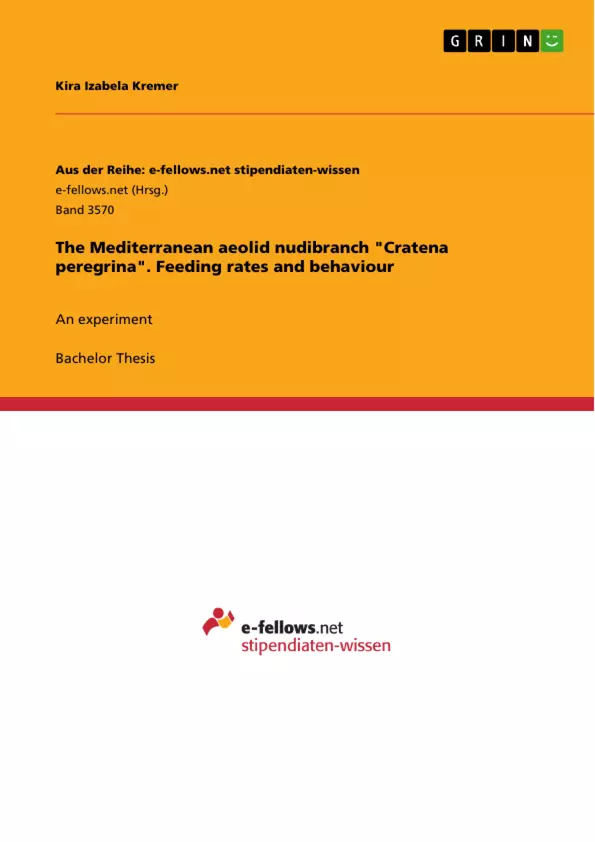In order to investigate the feeding behaviour and the feeding rate of Cratena peregrina, two different experiments were conducted. Behaviour experiments were performed in a tank and feeding rate experiments in a beaker. A total of 31 individuals was tested, 22 hours each, with full surveillance in during the trials.
There are three major research hypotheses investigated in this study:
1) Cratena peregrina is able to locate Eudendrium spec. colonies in its surrounding.
2) Cratena peregrina feeds systematically on the hydroid colonies.
3) The feeding rate correlates with the length of the molluscs.
This study was also conducted regarding possible contribution to the biomedical field, concerning the handling and observation of nudibranch specie. Moreover, it hopes to reveal useful information for further studies about the biology and ecology of nudibranchs.
For these purposes, two tests were developed: one for evaluating the feeding behaviour of Cratena peregrina and one for determining the feeding rate of the individuals.
Inhaltsverzeichnis (Table of Contents)
- Abstract
- Introduction
- 1. Introduction
- Materials and Methods
- 2.1 Collection and keeping
- 2.2 Length measurement
- 2.3 Feeding rate experiment
- 2.4 Feeding behaviour experiment
- 2.5 Eudendrium control
- 2.6 Video analysis
- 2.7 Data analysis
- Results
- 3.1 Eudendrium control
- 3.2 Feeding rate
- 3.3 Feeding behaviour
- Discussion
- 4.1 Eudendrium species
- 4.2 Feeding behaviour
- 4.2.1 Searching
- 4.2.2 Systematic feeding
- 4.2.3 Feeding breaks
- 4.3 Feeding rate
- 4.4 Egg ribbons
- 4.5 Experiment setup
- 4.6 Conclusion
- References
- Appendix
- Index of abbreviations
- Index of figures
- Index of tables
- Additional material
- Acknowledgement
Zielsetzung und Themenschwerpunkte (Objectives and Key Themes)
This study investigates the feeding behaviour and feeding rate of the aeolid nudibranch Cratena peregrina, focusing on its predatory relationship with hydroid polyps of the genus Eudendrium. The research aims to understand the impact of this nudibranch on the population dynamics of its prey and to explore the potential role of these molluscs in marine ecosystems.
- The feeding behaviour of Cratena peregrina and its impact on Eudendrium populations.
- The role of Cratena peregrina in regulating prey population dynamics.
- The diversity of hunting strategies and chemical substances produced by nudibranchs.
- The potential for medical applications of substances produced by nudibranchs.
- The significance of nudibranchs in understanding the complexities of marine processes.
Zusammenfassung der Kapitel (Chapter Summaries)
The introduction provides an overview of nudibranchs, highlighting their diversity, feeding strategies, and ecological importance. It focuses on Cratena peregrina, its prey (Eudendrium species), and the potential for this species to regulate prey populations. The study's methodology is described in detail, outlining the collection and maintenance of nudibranchs, feeding rate and behaviour experiments, video analysis, and data analysis techniques. The results section presents the findings of the feeding rate experiments, revealing a mean feeding rate of 23.96 polyps per hour, independent of individual size. Behavioural experiments revealed systematic feeding and interruptions by breaks, both patterns deemed significant. The discussion delves into the potential impact of Cratena peregrina on Eudendrium colonies in the Mediterranean, emphasizing the significant role nudibranchs play as predators within their respective biotopes.
Schlüsselwörter (Keywords)
The primary focus of this study is on the feeding behaviour and feeding rate of the aeolid nudibranch Cratena peregrina, its predatory relationship with the hydroid polyps of the genus Eudendrium, and the potential impact of this species on the population dynamics of its prey. Key concepts include: nudibranchs, feeding behaviour, predatory relationship, Eudendrium, population dynamics, marine ecosystems, chemical substances, medical potential, and ecological significance.
- Arbeit zitieren
- Kira Izabela Kremer (Autor:in), 2019, The Mediterranean aeolid nudibranch "Cratena peregrina". Feeding rates and behaviour, München, GRIN Verlag, https://www.grin.com/document/899894



